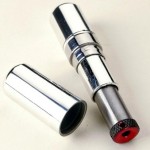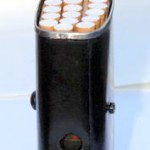(1) After half a decade of speculation, a British official has publicly admitted that English spooks were spying in Moscow with the help of a fake “spy rock.” The hollowed out rock, filled with electronic equipment, allowed the British spies to covertly transmit files to and from the rock by simply walking by it. (Ren-TV/Pressphotos/Getty Images)
-
(2) It must have just looked like a normal umbrella to Georgi Markov, a Cold War-era Bulgarian pro-Western dissident, as he waited for a bus in London in 1978. But one mysterious move and presumably a sharp pain later and Markov was condemned to death. The umbrella, it turned out, had been tipped with a needle that injected him with a deadly protein-based toxin. (Michael Fresco / Rex USA)
-
(3) Aptly named “The Kiss of Death,” Russia’s infamous former security service, the KGB, used this sleek and sexy device to take out targets from extremely close range, according to the International Spy Museum in Washington, D.C. The lipstick container also held a single 4.5 mm shot – small caliber but still potentially deadly. (Newscom)
-
(4) Not to be outdone by its Russian counterparts, the CIA dove just as deep into the extreme gadget game. Pictured here in a photo provided by the Agency is the Dragonfly, an unmanned aerial vehicle, developed in the 1970s. The tiny surveillance craft was the first “micro UAV” the size of an insect to take flight, the CIA said. (CIA/AP Photo)
-
(5) The British ploy with the fake rock is hardly a new idea. Back in the early 1970s, the U.S. tried a similar trick in Moscow with a tree stump. In this case, the equipment hidden in the fake stump was designed to intercept Russian communications coming from a nearby Russian air base. But like the British “spy rock,” the “spy stump” was uncovered by the ever-vigilant Russian security service. (International Spy Museum)
-
(6) The debonair tuxedoed man may just be reaching for a smoke, or, thanks to a specially designed cigarette case, he could be snapping off pictures as part of a sophisticated surveillance operation. Also on display at the International Spy Museum, this Cold War-era cigarette case has a miniature camera hidden in the side. (Michael Fresco / Rex USA)
-
(7) While the famous “shoe phone” from the classic spy comedy “Get Smart” may have seemed ludicrous, it really wasn’t that far from reality. On display at the International Spy Museum is the “spy shoe,” a device created by the KGB that hid a radio transmitter and microphone in the heal of a normal brown shoe, allowing the wearer to eavesdrop on and transmit secret conversations just by walking by. (International Spy Museum)
-
(8) Secret gadgets have a history further back than their heyday in the Cold War. During the Second World War, U.S. Army intelligence officers developed a way to turn a regular water canteen into booby-trapped explosives, according to the International Spy Museum. (International Spy Museum)
-
(9) Mark Stout, a historian at the International Spy Museum, said each of the world’s best intelligence services are thinking all the time about the most creative ways to hide secrets in plain sight. The “dog doo transmitter” is certainly an example. Reportedly used in Vietnam, this fake excrement was actually meant to resemble Tiger feces and was used as a homing beacon to direct aircraft. (International Spy Museum)










